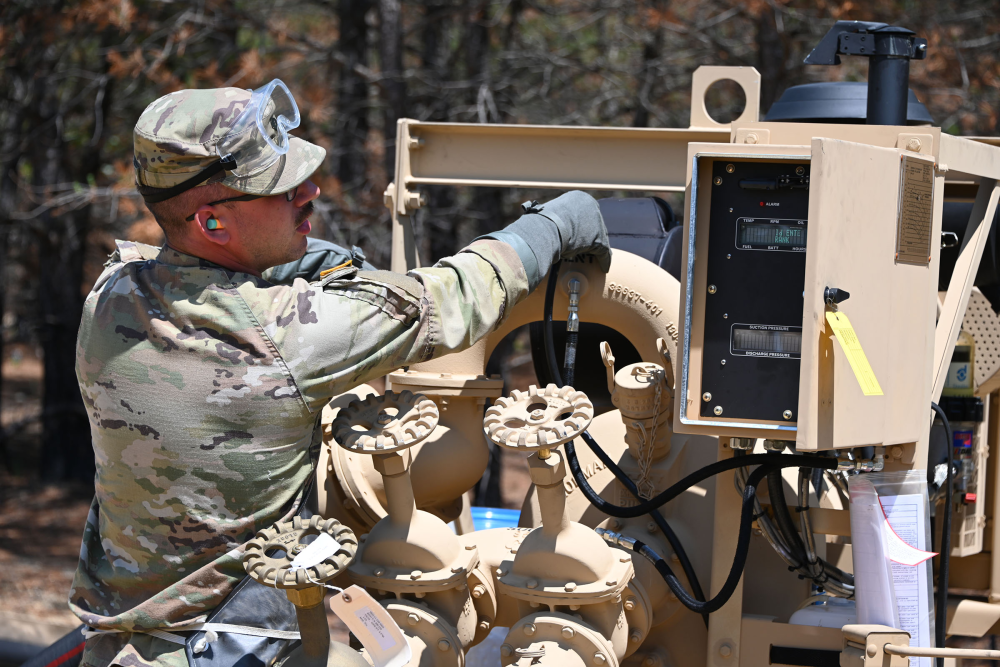Army Leaders Say Data is Key to Tackling Contested Logistics
“On this battlefield, the most decisive commodity for improved sustainment is data,” Maj. Gen. Mark Simerly said.

The U.S. Army will require a skilled data workforce, predictive logistics and the convergence of the service’s enterprise business systems to successfully adapt a data-centric sustainment warfighting function, Maj. Gen. Mark Simerly, Commanding General for the Combined Arms Support Command and Sustainment Center of Excellence, said this week.
Sustainment, one of the primary warfighting functions ensuring that troops have the necessary supplies and equipment to effectively carry out military operations, is becoming increasingly challenging to manage, especially as the Army prepares to transform how it operates for potential large-scale combat operations.
“On this battlefield, the most decisive commodity for improved sustainment is data,” Simerly said Tuesday at the Potomac Officers Club’s Army Summit. “Large-scale combat operations in the battlefield require a significant transformation of army sustainment.”
“When you hear ‘contested logistics,’ it’s always been contested at the tactical level. It’s now the breadth from tactical to strategic that’s different. Every line of communication is contested, extended and congested, and, of course, our ability to communicate is also denied, degraded, intermittent and limited…As a result, all sustainment operations will be distributed, dispersed and disrupted. And that means that sustainment will require greater speed, mass and convergence,” he added.
Russia’s invasion of Ukraine, the leaders emphasized, acts as a reminder that “war hinges on logistics.” The service updated its operational doctrine last year to prepare for multi-domain operations on land, as well as across sea, air, space and cyberspace, where it acknowledged the challenges it faces deploying troops in constantly contested environments.
“On this transparent battlefield, as certainly we’re seeing in the war in Ukraine, everything can be seen, and everything that can be seen can be targeted and killed. And this large-scale combat operation battlefield is contested in all domains, from the tactical to the strategic level,” Simerly said.
“We know that a transparent battlefield with persistent contact, logistics will be one of the very first places that any adversary will choose to target us. Tactical level for sure, as we’re learning in this fight, but up to the strategic level as well,” he added.
Col. Chris Hill, Army Materiel Command chief of data and analytics, said the first thing they learned from the war in Ukraine and the importance of data for enabling logistics in contested environments is the pace at which the requirements for analytics shift as the combat shifts.
“If you haven’t set up your supporting the ecosystem in terms of data and analytics to be able to meet that, you will never get ahead… We’ve probably had five major shifts in our analytic approaches, they’re just based on what’s going on and you have to have the agility to be able to do that,” Hill said.
As the Army is shifting its organizational forces from the long-standing brigade-centric approach to the one focused on divisions, the logistic forces will need to be predictive and precise to better support smaller and more dispersed units.
“So what we’ve learned based on our recent experiences is, first of all, you have to be predictive. If we can’t get ahead and use the analytics and the data to forecast what that warfighter needs ahead of time and get it there before it becomes an issue,” Hill said.
“The second thing is we have to be precise…And what that really means is because you’re contested both by threat and by geography, you have to optimize what you position where. You can’t go back to the approaches we’ve used in logistics historically where we just keep sending equipment and supplies and letting it stock up,” he added.
This is a carousel with manually rotating slides. Use Next and Previous buttons to navigate or jump to a slide with the slide dots
-

DHS, DOD Officials: AI is a Teammate, Not a Tool
AI can work alongside government by providing better information to humans for them to make real-time decisions.
5m read -

IRS Tax Filing Pilot Part of Digital-First Customer Experience Plan
Many taxpayers increasingly expect flexible, easy and self-directed digital interactions, agency leaders said.
5m read -

Federal Agencies Make the Case for Quantum
Amid development of emerging technologies like AI and machine learning, leaders see promise in quantum computing.
6m read -

NCI Program Unlocks Emerging Proteomic Data to Advance Precision Medicine
Researchers say sharing molecular cancer research data can expand cancer treatment and care.
32m listen




